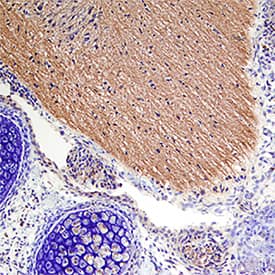Human/Mouse Sonic Hedgehog/Shh N‑Terminus Antibody
R&D Systems, part of Bio-Techne | Catalog # AF464

Key Product Details
Species Reactivity
Validated:
Cited:
Applications
Validated:
Cited:
Label
Antibody Source
Product Specifications
Immunogen
Cys25-Gly198 (Lys122Arg)
Accession # Q62226
Specificity
Clonality
Host
Isotype
Scientific Data Images for Human/Mouse Sonic Hedgehog/Shh N‑Terminus Antibody
Detection of Human and Mouse Sonic Hedgehog/Shh by Western Blot.
Western blot shows lysates of human stomach tissue and mouse stomach tissue. PVDF membrane was probed with 1 µg/mL of Goat Anti-Mouse Sonic Hedgehog/Shh N-Terminus Antigen Affinity-purified Polyclonal Antibody (Catalog # AF464) followed by HRP-conjugated Anti-Goat IgG Secondary Antibody (Catalog # HAF109). A specific band was detected for Sonic Hedgehog/Shh at approximately 50 kDa (as indicated). This experiment was conducted under reducing conditions and using Immunoblot Buffer Group 1.Sonic Hedgehog/Shh in Mouse Embryo.
Sonic Hedgehog/Shh was detected in immersion fixed frozen sections of mouse embryo (13 d.p.c.) using Goat Anti-Human/Mouse Sonic Hedgehog/Shh N-Terminus Antigen Affinity-purified Polyclonal Antibody (Catalog # AF464) at 15 µg/mL overnight at 4 °C. Tissue was stained using the Anti-Goat HRP-DAB Cell & Tissue Staining Kit (brown; Catalog # CTS008) and counterstained with hematoxylin (blue). Specific staining was localized to developing brain. View our protocol for Chromogenic IHC Staining of Frozen Tissue Sections.Applications for Human/Mouse Sonic Hedgehog/Shh N‑Terminus Antibody
Immunohistochemistry
Sample: Immersion fixed frozen sections of mouse embryo (13 d.p.c.)
Western Blot
Sample: Human stomach tissue and mouse stomach tissue
Reviewed Applications
Read 2 reviews rated 5 using AF464 in the following applications:
Formulation, Preparation, and Storage
Purification
Reconstitution
Formulation
Shipping
Stability & Storage
- 12 months from date of receipt, -20 to -70 °C as supplied.
- 1 month, 2 to 8 °C under sterile conditions after reconstitution.
- 6 months, -20 to -70 °C under sterile conditions after reconstitution.
Background: Sonic Hedgehog/Shh
The hedgehog (hh) gene encoding a secreted protein was originally identified in Drosophila as a segment polarity gene. The vertebrate homologues of Hh comprise several proteins including sonic hedgehog (Shh), Indian hedgehog (Ihh), and Desert hedgehog (Dhh). Hedgehog proteins are important signaling molecules during embryonic development. Shh genes are highly conserved and have been identified in a variety of species including human, mouse, frog, fish, and chicken. Mouse and human Shh are 92% identical at the amino acid sequence level. Shh is expressed in key embryonic tissues such as the Hensen’s node, the zone of polarizing activity in the posterior limb bud, the notochord, and the floor plate of the neural tube. Shh is involved in regulating the patterning of the developing central nervous system, somite, and limb. Shh plays an important role in the development of particular tissues such as whisker, hair, foregut, tooth and bone. Evidence also suggests that Shh is involved in regulating stem cell fates of neural and hematopoeitic lineages, and that aberrant Shh signaling is implicated in basal cell carcinomas and other diseases.
Mouse Shh cDNA encodes a 437 amino acid residue with a predicted 24 aa residue signal peptide that is cleaved to generate a 413 aa residue precursor protein. An autocatalytic reaction yields a 19 kDa amino-terminal domain Shh-N protein containing cholesterol and palmitate, and a 27 kDa carboxy-terminal domain Shh-C protein. The N-terminal domain retains all known signaling capabilities, while the C-terminal domain is responsible for the intramolecular processing, acting as a cholesterol transferase. Shh can act as both a short-range contact dependent factor and as a long-range, diffusible morphogen. At the cell surface, Shh activity is mediated by a multicomponent receptor complex involving the 12-pass transmembrane protein Patched (Ptc) which binds Shh with high affinity and Smoothened (Smo), a signaling seven transmembrane G-protein coupled receptor. In the absence of Shh, Ptc represses Smo activity. The binding of Shh to Ptc, releases the basal repression of Smo by Ptc (1‑5).
References
- Carpenter, D. et al. (1998) Proc. Natl. Acad. Sci. USA 95:13630.
- Perrimon, N. (1995) Cell 80:517.
- Weed, M. et al. (1997) Matrix Biol. 16:53.
- Mullor, J. et al. (2002) Trends Cell Biol. 12:562.
- Ingham, P. and A. McMahon (2001) Genes & Dev. 15:3059.
Alternate Names
Gene Symbol
UniProt
Additional Sonic Hedgehog/Shh Products
Product Documents for Human/Mouse Sonic Hedgehog/Shh N‑Terminus Antibody
Product Specific Notices for Human/Mouse Sonic Hedgehog/Shh N‑Terminus Antibody
For research use only

